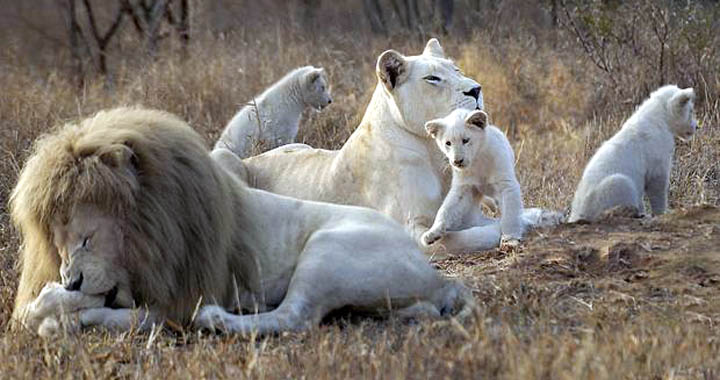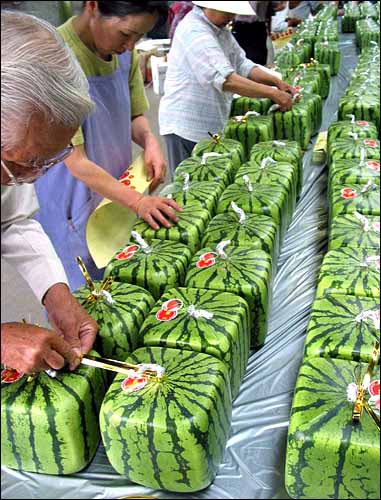
Sunday, November 7, 2010
Friday, June 5, 2009
White Lions
White Lions, not albino but white fur and blue eyes, were technically extinct in Africa.
They're considered sacred by the native tribes, but a prized trophy by big game hunters, and they were almost wiped out.
The Global White Lion Trust gathered the remaining cats and have been breeding them in captivity. Now they are ready to
release the second pride back into the wild.
Quote:
| "Our team, led by Jason Tuner, has worked tirelessly to ensure the lions are ready for their reintroduction and the tagging is an important part of the process as it will help to monitor the pride's hunting behaviour." The Cubs are fitted with tracking systems under their skin so growth can be monitored. |


Thursday, June 4, 2009
Thought you'd seen it all did you?
In Japan, land of efficiency, someone decided square was better. Then someone decided to one-up the square with pyramidal shapes. What's next?




They are created by growing them in tempered glass boxes, (see the one below), or in the other case acrylic pyramids.

Before you run out and buy these you might want to rethink it. At $100 for a square ones and $82 for the pyramids you might want to opt for the old fashioned round one instead!!




They are created by growing them in tempered glass boxes, (see the one below), or in the other case acrylic pyramids.

Before you run out and buy these you might want to rethink it. At $100 for a square ones and $82 for the pyramids you might want to opt for the old fashioned round one instead!!
Saturday, May 23, 2009
Monday, May 18, 2009
Potato Portraits by Ginou Choueiri
 Las Papas art installation by Ginou Choueiri consists of hundreds of potato portraits that grow, live, and then eventually decay and die.
Las Papas art installation by Ginou Choueiri consists of hundreds of potato portraits that grow, live, and then eventually decay and die.“I chose the potato to portray human faces because of the many striking parallels. Not only is their skin porous like ours, but their skin texture and color is very similar, and like us, they come in different sizes, shapes and forms.” - Ginou Choueiri [via]
Saturday, June 7, 2008
Too much coffee perhaps...!
Let this be a lesson to you all......be nice.....be very nice to your co-workers!!!!
Saturday, November 17, 2007
A short history of the Basenji
The Basenji is a natural breed, lightly built, finely boned and aristocratic looking with a history going further back than written record: its presence has been recorded in Egyptian engravings, both as a family pet and as a hunting dog.
There are pictures of Basenji's on the Egyptian tombs dating back to pre-3000BC and they are still found in their native Africa.
Basenjis are highly valued by the African tribesmen because of their hunting abilities. It has been reported that some tribesmen held these dogs in such high regard that they cost more than a wife. Although, sadly, in some tribes, if the hunting instinct was lacking they ended up in the cooking pot.
The African hunter, more often that not, carries the Basenji around his neck when he is not actually workig. Because the Basenji is barkless it is fitted with a bell, made from a dried gourd with a monkey bone-clapper or filled with pebbles, that is fixed around it neck. Generally the dog is used as a beater, driving the game towards nets manned by hunters, who then dispatch the prey. It will also circle an animal at great speed, holding it at bay until the hunter arrives to deal with it.
Basenjis were brought to Australia in 1946, by Dr Caselberg, who bred them until 1953. Most of these early dogs went to pet homes, and from 1957 to 1960 no Basenjis were bred in Australia. However, they were being bred in New Zealand and around 1960, Basenjis reappeared in Australia. By 1970 Basenjis were being bred in almost every state.
This is an excerpt from a book written by Veronica Tudor-Williams, "Basenjis, The Barkless Dogs". Possibly no one could be better qualified to describe the many charms of the Basenji.
" Much of the charm of Basenjis lies in their individuality and in their extreme intelligence. At times, no dog can be naughtier than a Basenji, but no dog has brought apology to a finer art. How can one be cross with an animal which lies on its back with both paws folded over its eyes, or stands on its head turning somersaults, or peeps round the door watching the reactions of an indignant owner, yodelling loudly when it finds the moment of retribution can no longer be averted?
There are pictures of Basenji's on the Egyptian tombs dating back to pre-3000BC and they are still found in their native Africa.
Basenjis are highly valued by the African tribesmen because of their hunting abilities. It has been reported that some tribesmen held these dogs in such high regard that they cost more than a wife. Although, sadly, in some tribes, if the hunting instinct was lacking they ended up in the cooking pot.
The African hunter, more often that not, carries the Basenji around his neck when he is not actually workig. Because the Basenji is barkless it is fitted with a bell, made from a dried gourd with a monkey bone-clapper or filled with pebbles, that is fixed around it neck. Generally the dog is used as a beater, driving the game towards nets manned by hunters, who then dispatch the prey. It will also circle an animal at great speed, holding it at bay until the hunter arrives to deal with it.
Basenjis were brought to Australia in 1946, by Dr Caselberg, who bred them until 1953. Most of these early dogs went to pet homes, and from 1957 to 1960 no Basenjis were bred in Australia. However, they were being bred in New Zealand and around 1960, Basenjis reappeared in Australia. By 1970 Basenjis were being bred in almost every state.
This is an excerpt from a book written by Veronica Tudor-Williams, "Basenjis, The Barkless Dogs". Possibly no one could be better qualified to describe the many charms of the Basenji.
" Much of the charm of Basenjis lies in their individuality and in their extreme intelligence. At times, no dog can be naughtier than a Basenji, but no dog has brought apology to a finer art. How can one be cross with an animal which lies on its back with both paws folded over its eyes, or stands on its head turning somersaults, or peeps round the door watching the reactions of an indignant owner, yodelling loudly when it finds the moment of retribution can no longer be averted?
Their own particular noise is best described as a mixture of a chortle and a yodel. Basenjis use this unique gift as a form of speech, as one owner said,
"they do not bark, they talk," different intonations of yodel being used to express different reactions.
They are very sensitive as a breed, responding to love and kindness, and they should never be shouted at or treated roughly.
Their extreme cleanliness, ease of house training and total lack of doggy smell makes them hard to beat as house pets. They are known to wash themselves like cats, and will dry each other and their owner's clothes after a walk in the rain, whilst a human having a bath holds endless fascination, the washing and drying being helped and hindered all the time.
After a few days, they are no longer dogs around the house, but a fascinating, lovely part of a home. In fact, they are dogs, cats, children and the essence of the wild all in the form of a little imp."
By Veronica Tudor-Williams.
Well I hope you have found this interesting and have learnt something new today, it's always good to learn something new each day.
Subscribe to:
Posts (Atom)








